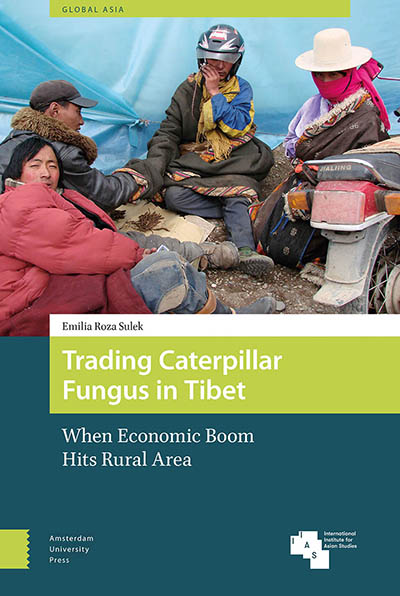Trading caterpillar fungus in Tibet
Reviewed title:
Emilia Roza Sulek. 2019.
Trading Caterpillar Fungus in Tibet: When Economic Boom Hits Rural Area
Amsterdam: Amsterdam University Press
ISBN 9789462985261
The caterpillar fungus (ophiocordyceps sinensis) is a curious species, ubiquitous in the Himalayas and in southwest China, but almost unheard of in other parts of the world. In the Tibetan language, the term for the creature is yarsta gunbu (literally summer grass winter worm), due to its peculiar nature: it is a parasitic fungus that slowly takes over and replaces the body of the larvae of a moth. Emilia Roza Sulek’s book explores the people, practices, and livelihoods that revolve around the harvest and exchange of this caterpillar fungus (yartsa in short). It is one of those wonderful ethnographies where complex economies unfold through a single important commodity.
What is so special about yartsa? Mostly valued as a miraculous cure-all treatment in China and abroad, sometimes referred to as the ‘Himalayan Viagra’, it is rarely used as medicine amongst the Tibetan pastoralists themselves. In the early 2000s, spurred on by post-reform changes in China – increased infrastructural links in the region, rising consumerism, and a growing concern with health – its popularity and price skyrocketed “to such a degree that its market value overshadowed its other uses” (p.86). Yartsa began to be used and exchanged as currency itself and was said to have exceeded the price of gold up until the 2008 financial crisis. While other books about single commodities – for instance salt or jade or cod or tea – focus on the objects themselves, Sulek’s book prioritises the people, the pastoralists in Golok, eastern Tibet, whom she dubs ‘the protagonists’. Paying close attention to the contemporary transformation of their land and lives, the focus is less on the yartsa itself and more on the broader question, ‘what happens when the land you live on suddenly increases in value and importance?’.
According to Sulek, economic improvements in Golok had more to do with the caterpillar fungus trade than with state investments (p.19). While it can also be read as a book about recent rural development in Tibet, Sulek rightly avoids a linear or teleological understanding of the term. Sulek demonstrates that the yartsa trade reveals creative adaptation and ‘flexibility of existing structures’, showing how a single product can completely reorganise a society. This is especially clear when Sulek explores what happens when informal trading practices begin to be regulated by the state, although somewhat unofficially. While state discourse maintains that digging yartsa is environmentally detrimental, they put the onus on pastoralists to self-manage their trading land as ‘protectors of the environment’. What this meant in practice was that outsiders could not come to the region to help dig for yartsa. Sulek keenly observes that under the guise of giving the pastoralists more self-management, such regulations actually limited their management, justifying interventions into pastoralists’ lifestyles, such as sedentarisation programmes (p.210).

Sulek’s book is clearly written, even sensual. The author has a gift for descriptions of nature, somewhat reminiscent of Hayao Miyazaki films. Take for example this passage: “Soglung is a long valley with a small stream murmuring on its stony river bed. The water swarms with tiny fish and there are swampy meadows with frogs” (p.52). Ethnographers will recognise the thickest of descriptions during an account of a day of yartsa-digging, preceded by milking the dri (the female yak), a methodological exemplar of ‘deep hanging-out'. Sulek spends months on end living with and picking yartsa with families, providing us with rich, micro-level descriptions of pastoralist life, and pinpointing where the various flows of money are going – not an easy task unless one understands the ins and outs of daily exchange practices. This book also contains an excellent up-to-date description of Tibetan bargaining techniques; negotiating the price of yartsa by grasping combinations of the buyer’s or seller’s fingers under long sleeves or a hat.
My only two minor qualms have little to do with the content of the book itself. First, the steep price means that only a small minority of readers will be able to obtain it, likely through limited access to a university library or interlibrary loan. It is a pity that the relative inaccessibility of Sulek’s book may reproduce the idea that it is ‘specialist’, while it is in fact of interest to much wider audiences in Himalayan/China Studies, Development, Anthropology, Geography, and related disciplines. An open access version would be highly welcome. Secondly, the majority of the numerous footnotes contained fascinating information that I would have liked to have seen in the main body of the text.
This is a captivating and enjoyable book to read in its entirety. It may not provide cutting-edge theoretical arguments, but that was not Sulek’s aim. Rather, it is a detailed ethnography that unfolds to reveal socio-economic change in a subtle, slower way. In fact, its focus on how capitalist change occurs in practice, long-term ethnographic engagement, and future outlook can be compared to other detailed ethnographies of rural change, such as Tania Li’s Land’s End (Duke University Press, 2014). Sulek captures snapshots of contemporary pastoral life in Tibet and provides a solid example of how a sudden influx of income can change lives. Since the Tibetan pastoralists hardly use or identify with yartsa in the same way its consumers do, Sulek shows how rural pastoralists can creatively capitalise on their own resources to their own advantage. Trading Caterpillar Fungus in Tibet does not contain simple people-versus-the-state arguments. Much more complex, it exposes how pastoralists become the “creators of the transformations of their own socio-economic lives”, but never in a uniform way (p.258).
Tina Harris, University of Amsterdam, The Netherlands